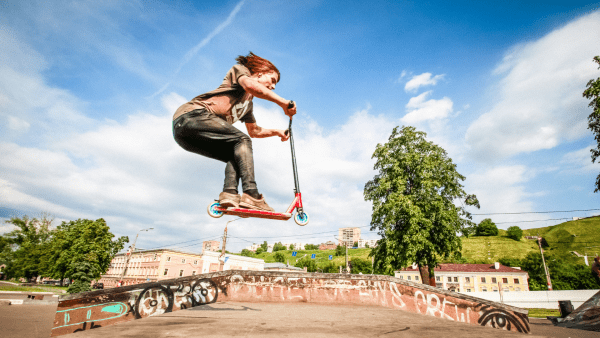If you’re passionate about perfecting your scooter skills, we’ve got something that’ll surely pique your interest – a Scooter Trick Chart Progression! At FamilyHype, we understand how important it is for parents to ensure their children are engaging in safe activities and mastering the best tricks in a fun and safe way. That’s why we’ve created this innovative tool to help riders of all levels systematically enhance their tricks and techniques.

But what exactly is this chart, and how do you use it? In this article, we’re breaking down the details of a scooter trick chart progression, guiding you through its structure and showing you how to use it to monitor your progress. We’ll also share tips on advancing safely to more complex tricks. Our aim is to help each one of us elevate our scooter game while ensuring safety and fun at all times. So whether you’re just starting out or looking for ways to master many other tricks, stick with us as we navigate through this exciting journey together!
Key Takeaways
At FamilyHype, we understand the value of family and the importance of safety for family members of all ages, which is why we highly recommend using a scooter trick chart progression. This chart is the perfect tool to help riders track their progress safely and efficiently, from the basics of scootering, such as balancing, pushing, and riding, landing, to more complex tricks, such as kickflips, grinds, and frontside flips.
When it comes to scooters, it’s important to progress steadily and enjoy the ride. A scooter trick chart progression allows you to measure your progress and ensure that you are not rushing into complex tricks. By tracking your progress, you can stay safe and have more fun.
Keep practicing and enjoy the ride!
Defining A Scooter Trick Chart Progression
You’re probably wondering, what exactly is a scooter trick chart progression? Well, let’s dive right in and get that clarified for you.
In essence, it’s a guide with scooter terminology detailing the order of tricks to learn. The chart design mirrors one’s journey from beginner to pro, focusing on skill development and safety. Please note this content is only for kick scooters and not gas powered scooters.
Now that we’ve defined it, let’s delve into understanding the structure of this helpful tool.
At FamilyHype, we understand the importance of family and the need for parents to find quality content to help their children develop in a safe and meaningful way. This scooter trick chart progression is just the tool you need to keep your children safe while they explore the world of scooters. It’s designed to help the learner progress from basic moves to more complex tricks, all while keeping safety in mind.
The chart covers a variety of scooter trick terms, such as the Kicker, the Tailside, and the HiptoHip. It also includes a variety of attributes, like the speed of the trick, the level of difficulty, and the necessary safety equipment. Finally, the chart outlines the value of each trick, such as balance, control, and finesse. By following this chart, scooter enthusiasts can track their progress from beginner to pro and even share their successes with friends and family.
We hope this scooter trick chart progression helps you and your family have a fun and safe experience while learning new scooter tricks.
Understanding The Structure Of The Chart
Now, let’s delve into the structure of the scooter trick chart progression. We’ll discuss how tricks are ordered and understand how their difficulty levels are determined.
This will help us to effectively use the chart as a guide for advancing our skills in scooter tricks.
Order Of Tricks
Understanding the order of tricks on a scooter trick chart progression is vital, as it’s designed to guide riders from simpler maneuvers to more complex ones. The sequence usually has four key phases:
- Basic tricks mastering
- Trick variations exploration
- Scooter maintenance training
- Advanced stunts learning
These orderly stages equip you with essential skills to serve other riders better. FamilyHype strongly believes that understanding the order of tricks is important and encourages riders to share their experiences and opinions about the order of tricks and the scooter progression chart.
The chart is designed to help riders of all skill levels progress from easier tricks to harder ones. Through careful practice, progression, and mastering of the order of tricks, riders can make their way up the scooter trick chart progression.
Next, let’s delve into understanding difficulty levels in the chart.
Difficulty Levels
Navigating through different difficulty levels of scooter tricks can be quite a thrill, as it’s not only about mastering the tricks but also pushing your limits and enhancing your skills. We learn to conquer trick variations, gradually achieving balance mastery.

This journey serves to fuel our passion for scooting. Scooters come in various forms, such as electric scooters, self-balancing scooters, and stunt scooters. Additionally, they can be categorized by difficulty level, with beginners’ scooters, intermediate scooters, and advanced scooters.
No matter what type of scooter you have, FamilyHype encourages you to challenge yourself and explore your scooter capabilities. Now that we’ve explored how these charts work let’s delve into practical ways of integrating this knowledge into your regular practice routine.
How To Start Using The Chart
Diving into the world of scooters can be thrilling, and with FamilyHype’s progressive chart, you’ll have a step-by-step guide to get you started.
Here’s how:
- Customize the chart to match your skill level.
- Learn from beginner mistakes by studying past failures.
- Commit to gradual improvement rather than abrupt leaps.
Next, let’s navigate ways to progress safely and effectively on this journey. Scooter tricks require mastering the basics of maneuverability, balance, and control. These fundamentals include riding on flat surfaces, turning handlebars, and executing tricks like wheelies, jumping, and grinds.
Additionally, safety should be top of mind, with protective gear such as helmets for your head, pads, and gloves. With the right tools, knowledge, and practice, you can master the art of scooters and have a safe and enjoyable experience.
Tips For Progressing Safely And Effectively
Having embarked on our journey with the scooter trick chart progression, it’s crucial to consider safety. As FamilyHype promotes a safe and secure environment for our readers, protective gear is an absolute must for scooter users.
Helmets, knee pads, and elbow guards should be worn when attempting new tricks. Practicing injury prevention techniques is equally vital to ensure the safety of the rider.
Furthermore, monitoring advancements effectively is key to progressing safely and without feeling overwhelmed. By breaking down the steps into smaller goals, riders can better keep track of their achievements.
Scooters, when used properly, can be an enjoyable and thrilling activity for the whole family.
Tracking Your Progress
If you’re looking to get the most out of your scooter experience, keeping a detailed journal of your journey with FamilyHype will paint a vivid picture of your growth and improvements over time. We recommend taking note of consistency, setting achievable goals, and monitoring progress along the way.
Consistency helps identify patterns or habits in your riding, while achievable goals give you something to strive for and keep you motivated and focused. With this, we’re ready to explore the exciting world of mastering more complex tricks and furthering your scooter journey.
How To Advance To More Complex Tricks
Ready to take your skills to the next level? Let’s delve into mastering more complex maneuvers on your two-wheeler.
We recommend gradually exploring scooter trick variations, incorporating easy trick combinations, and exploring new scooter tricks safely and steadily. As you progress, the excitement and thrill of mastering these amazing scooting feats will bring you joy!

We can look at them from the perspectives of type, terrain, and skill level. We can further break down types into kick scooters, folding mechanism scooters, electric scooters, and gas-powered scooters. Terrain can be divided into street, land, park, off-road and other obstacles. Skill levels can be broken down into beginner, intermediate, and advanced.
Knowing these distinctions will help you to advance from simple tricks to more complex tricks. No matter which level you’re at, you’ll find the right scooter for your needs.
Conclusion
When it comes to scooters, it’s important to track our progress and progress safely and efficiently. A scooter trick chart progression is a great tool to use for this purpose. It ensures that riders aren’t rushing into complex tricks but instead are taking steady steps towards mastery in an enjoyable and safe way.
Here at FamilyHype, we understand the value of family and the importance of safety for family members of all ages. That’s why we highly recommend using a scooter trick chart progression. This chart will allow you to track your progress, from the basics of scootering, such a way as balancing, pushing, and riding, to more complex tricks, such as kickflips, grinds, and frontside flips.
Remember, every scooter ride is an opportunity for improvement. Keep practicing and enjoy the ride! If you have any feedback about our content or your experience with scooter trick chart progressions, we’d love to hear from you.
Frequently Asked Questions (FAQs)
What Is The Hardest Trick On A Scooter?
One of the hardest tricks on a scooter is the “double backflip,” where the rider performs two full backflips in the mid air. Achieving a scooter flip during this can add complexity.
What Is The Easiest Trick On A Scooter?
One of the easiest tricks on a scooter is a “bunny hop,” where the riders jump off the ground with both wheels, specifically the front wheel, leaving the surface simultaneously. Often, beginners start by keeping their feet off the deck.
How Do I Get Better At Scooter Tricks?
To improve at scooter tricks, practice regularly on a good quality scooter deck, start with simple tricks like the heel whip and progress gradually, watch tutorials that might show moves like the bri flip, and seek guidance from experienced riders at your local bar or skatepark. Observing them can teach you maneuvers like the front scooter flip.
How To Do Intermediate Scooter Tricks?
Intermediate scooter tricks can include tailwhips, quarter pipe jumps, and 180-degree spins. Practice proper techniques, like getting some air before attempting a front scooter trick, build confidence, and gradually increase difficulty.
What Makes A Scooter Faster?
Several factors can make a scooter faster, including larger wheels, high-quality bearings, reduced friction, and a lighter overall weight. A well-maintained wheel and a quality scooter deck can also contribute.
Is A Scooter Harder Than A Bike?
The difficulty of riding a scooter versus a bike depends on individual preferences and skills, but scooters are generally considered easier for beginners due to their simpler controls and smaller size.
How Do You Hop Higher On A Scooter?
To hop higher on a scooter, bend your knees, use your arms for lift, and focus on a quick and explosive jump.
How Do You Bunny Hop Higher On A Scooter?
To bunny hop higher on a scooter, practice using your body weight to lift the front and back wheels off the ground simultaneously, then tuck your knees in to gain extra height.
How Do You Do A 360 On A Scooter?
To perform a 360 on a scooter, ride at a moderate speed, initiate the spin by turning your shoulders and hips, and use your arms for balance during the rotation.
What Is The Best Sitting Position On A Scooter?
Scooters are generally ridden standing up, and there is no specific sitting position. Riders should have both feet on the scooter deck and use their legs and body for control and balance. Whether you’re riding down a straight path or attempting a front scooter flip, maintaining balance is crucial.
